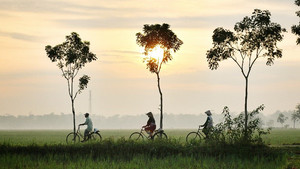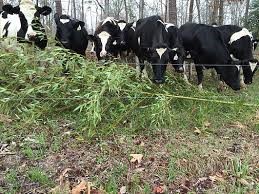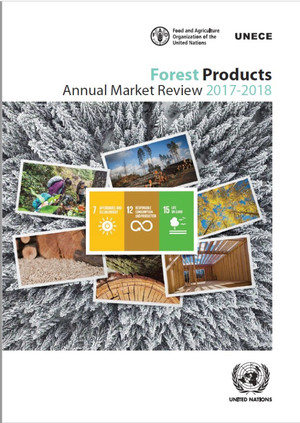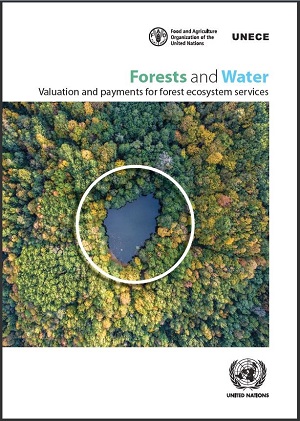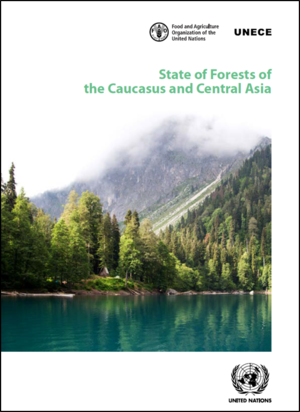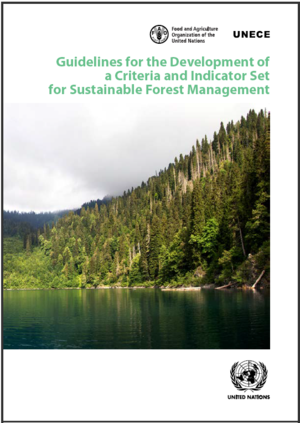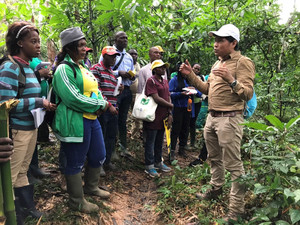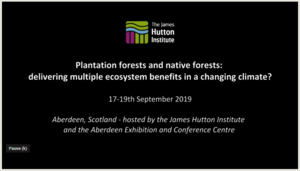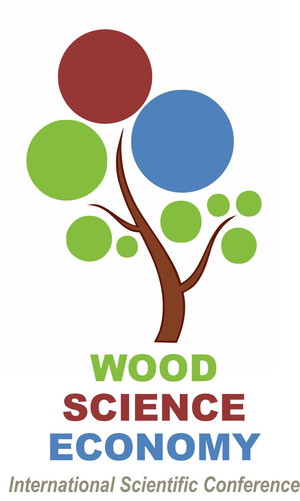Forest Information Billboard
Issue 2, June 2019

ANNOUNCEMENT: The theme for the International Day of Forests 2020 will be
FORESTS AND BIODIVERSITY.
SAVE THE DATE
25 - 27 June 2019: Expert Workshop and the Meeting of the Team of Specialists on Green Jobs in the Forest Sector, Madrid, Spain, http://www.unece.org/index.php?id=51529
4-7 November 2019: Forêt2019 - Joint Session of the ECE Committee on Forests and and the Forest Industry and the FAO European Forestry Commission, Switzerland, Geneva, http://www.unece.org/index.php?id=51124
23 March 2020: International Day of Forests - Forests and Biodiversity, Geneva, Switzerland, http://www.unece.org/index.php?id=51931
24 - 25 March 2020: 42nd Session of the Joint ECE/FAO Working Party on Forest Statistics, Economics and Management, Geneva, Switzerland, http://www.unece.org/index.php?id=51934
For more details about upcoming events, please refer to the meeting website and the "Events" section at the bottom of the Billboard. All UNECE/FAO meetings are listed here: UNECE/FAO meetings.
Forest reporting
UNECE and FAO take stock of the state of forests of the Caucasus and Central Asia in first ever study
The forests of the Caucasus and Central Asia are vital in fighting erosion and desertification in the harsh climates of the region. They host a rich biodiversity and provide livelihoods for the rural population, who have few other sources of revenue. These forests also serve as important sources of wood for energy.
However, the forests are subject to strong pressures, reducing their area and quality and limiting their ability to perform protection and livelihood functions. There is excessive cutting to provide fuelwood for local communities, who have few alternative sources of energy. The grazing of animals vital to local communities also degrades forests. Local forest management units are often ill-equipped and under-resourced to carry out their tasks.
Until now, there has been little information available to the international community regarding the state of forests in the Caucasus and Central Asia.
At UNFF14, in May 2019, UNECE and FAO have released the “State of Forests of the Caucasus and Central Asia” report, the first regional overview of the forest sector in these countries since they became independent in the 1990s.
UN Deputy Secretary General celebrates the International Day of Forests in Geneva
Amina J. Mohammed, UN Deputy Secretary-General, Olga Algayerova, Executive Secretary of UNECE and Malgorzata Golińska, Secretary of State of the Polish Ministry of Environment celebrated the International Day of Forests on 21 March 2019 at the Palais des Nations, Geneva, under the theme Learn to Love Forests with a forest food breakfast and handicraft workshops from the State Forests of Poland, a long-time partner of the UNECE on forest work, and toured the “Paper Cave”.
The Paper Cave exhibition, sponsored by the Confederation of European Paper Industries, showcased innovative wood-derived products of the future: printed electronics on a greeting card, cutlery from wooden fibers which can be recycled up to 7 times, a ventilation system for airplanes which is made out of cardboard, stronger than spider silk biobased material which consists of nanosized cellulose fibres and innovative packaging materials made from post-consumer waste such as used coffee cups.
The UN Deputy Secretary-General received an ecosystem in a jar from Malgorzata Golińska. “We thought of distributing small forest ecosystems in a jar today to remind people of the many functions that forests have in our lives, from water purification to providing sustainable materials”, said Malgorzata Golińska.
Azerbaijan brings degraded land restoration commitments in Caucasus and Central Asia to 3 million ha
Azerbaijan has announced it will restore 170,000 ha of degraded lands by 2030, and an additional 100,000 ha conditional upon receiving funding, under the Bonn Challenge. The Bonn Challenge is a global effort to bring 350 million ha of degraded and deforested land into restoration by 2030.
With this commitment, Azerbaijan joins six countries in the Caucasus and Central Asia (Armenia, Georgia, Kazakhstan, Kyrgyzstan, Tajikistan and Uzbekistan), bringing the region’s collective commitments under the Bonn Challenge to about 3 million ha. These pledges were made in 2018 at the Ministerial Roundtable for Forest Landscape Restoration for the Caucasus and Central Asia, which also adopted the Astana Resolution, committing to strengthen partnerships and regional cooperation.
The pledge by Azerbaijan was made on 30 May 2019 at the Forest Congress for the Caucasus and Central Asia, convened by UNECE/FAO at lake Issyk Kul in Kyrgyzstan. The Forest Congress brought together stakeholders from the five Central Asian and three Caucasian countries to enhance regional cooperation for sustainable forest management.
Forest Congress for the Caucasus and Central Asia
In recent years, countries in the Caucasus and Central Asia have made significant progress in developing national forest monitoring systems and have committed to implement large-scale forest landscape restoration. The Astana Resolution and the commitment of the region in 2018 to restore over 2.5 million hectares of forests under the Bonn Challenge by 2030 were major milestones in this regard.
The countries of the region showcased their efforts and achievements at the UNECE/FAO Forest Congress, held 28-31 May 2019 in Kyrgyzstan. The Forest Congress brought around 60 stakeholders from the five Central Asian and the three Caucasian countries together to reflect on how to progress in highlighting and prioritising forestry issues on the national, regional and international agenda.
The United Nations recently declared 2021–2030 the Decade on Ecosystem Restoration. This offers unparalleled opportunity to create jobs, address climate change, and improve food security.
“For this region, the decade bears the unprecedented possibility to scale up restoration while fighting the climate crisis and negative impacts of degradation and desertification,” said Ekrem Yazici, deputy head of the UNECE/FAO Forestry and Timber Section, at the Congress.
Central heating and price competitiveness support wider and more efficient use of wood energy by German households
About half of the wood consumed in Germany is used for energy purposes. In 2015, residential wood energy consumption accounted for 49% in total wood energy consumption even exceeding corresponding demand by the wood processing industry (22%). Researchers at the University of Hamburg, Swedish University of Agricultural Sciences, Thünen Institute of International Forestry and Forest Economics, and Information Services for Resources (INFRO) assessed factors influencing wood energy consumption by German households. Heating technology, dwelling characteristics and alternative energies; woody biomass accessibility and weather; as well as households’ socio demographic characteristics helped explaining annual household wood energy consumption. A comprehensive econometric model was applied to survey data for years 2005, 2010 and 2014.
Results suggest that central heaters facilitate greater wood energy consumption. This finding points to support implementation of the German Market Incentive Programme as a tool to expand efficient residential wood energy consumption. Households’ wood energy consumption also showed strong response to changes in temperature and competing energy prices. Modeling outcomes are of particular interest given that both temperature and energy prices exhibit high variation across years. Better accessibility to wood resources were also associated with higher average residential wood energy consumption.
Policy implications stress that support to improvements in infrastructure, highly-efficient energy systems and programs that discourage fossil fuels can support the expansion of renewable and locally-sourced wood energy. The full article can be found at: https://authors.elsevier.com/a/1Z4Jl3QkGxsH9X.
UNECE/FAO conducted the 8th reporting round of the Joint Wood Energy Enquiry (JWEE) for the year 2017
UNECE/FAO conducted the 8th reporting round of the Joint Wood Energy Enquiry (JWEE) for the year 2017. A summary of preliminary data was provided at the 41st Session of the Joint ECE/FAO Working Party on Forest Statistics, Economics and Management in March 2019.
Country data suggest that woody enery maintained its important role in forest products markets and its leading role in renewable energy. For instance, Germany, which is among the largest economies in the ECE region, reported 59.8 million m³ wood energy consumption. This amount accounted for half of total wood use in the country.
In addition, country data suggest that 83% of total wood energy consumption derives from direct sources (e.g., from forests and non-forests lands) and forest-based industry (e.g., wood residues). The residential sector was the most important wood energy consumer (42%), exceeding the industry sector (30%) as well as the power and heat sector (23%).
The residential sectors sourced most wood energy from direct sources (80%). 88% of wood energy consumption in the industry sector derived from internal waste streams of the forest-based industry. The other sectors (Power and heat and “other”) showed a very heterogeneous pattern. However, overall most wood energy was sourced from direct sources as well as the forest-based industry. The full presentation inclusive of more preliminary data is available at: https://www.unece.org/fileadmin/DAM/timber/meetings/2019/20190327/2019-41-wp-item-08a-steierer-glasenapp.pdf
Forest2Market do Brasil Launches Timber Supply Analysis 360, an Interactive Map-Based Tool That Provides Forest Inventory Data
Forest2Market do Brasil is supporting the forest products industry expansion in Brazil with the launch of Timber Supply Analysis 360, an interactive map-based tool that provides forest inventory data to decision makers in the forest products industry. Timber Supply Analysis 360 provides the industry and its investors with current and accurate forest inventory data, which allows Forest2Market do Brasil to build robust long-term supply forecasts.
Timber Supply Analysis 360 allows users to select custom areas based on the location of a forest, the planned location for a new facility or around an existing facility with expansion plans. Once the location is selected, the tool provides the following data for the selected area:
- Hectares
- Species
- Total volume by species
- Volume by product
- Age class distribution
Timber Supply Analysis also provides the base data that Forest2Market do Brasil uses to produce long-term supply, demand and timber price forecasts. "In order to invest in a manufacturing facility or a plantation that could have a lifespan of 20+ years, companies need to look at the projected supply and projected demand and understand the effect that the relationship between these factors will have on future timber prices," says Pete Stewart, Founder, President and CEO of Forest2Market. “And now we can use this data, apply growth and yield models to simulate forest growth and our supply chain expertise to quantify local demand to produce long-term forecasts of forest inventory, supply and demand, and price." To read more about Timber Supply Analysis 360 for Brasil, click here.
Pour un positionnement forestier responsable dans le bassin du Congo - premisses d'une politique environnementale commune ?
Text link (in French) : here
Paper by Dr. Emmanuel Groutel - NIMEC (UPRES-EA 969) IAE de CAEN
Abstract in English:
This article presents the context of forestry in natural forests of the Congo Basin, with regard to Asian and domestic needs in Africa. It is proposed, referring to M. Porter's work, to position, then protect and expand a forestry model incorporating the principles of shared value creation. International support must then allow the states concerned, certified concessionnaires and communities to receive backing from international institutions according to a Common Environmental Policy organized according to the Sustainable Development Goals.
Working successfully at the science-policy interface: IUFRO at UNFF-14
The United Nations Forum on Forests (UNFF), the major international policy platform for forest- and tree-related issues, held its 14th session from 6-10 May 2019 at the UN Headquarters in New York.
Several IUFRO officeholders were invited to take part in the thematic panel discussions: Prof. Elena Paoletti, Task Force Coordinator, spoke on the “Forests and Climate Change” panel. Dr. Pia Katila, Coordinator of IUFRO-WFSE contributed to the UNFF-14 panel on “Forests, inclusive and sustainable economic growth and employment”.
Dr. Monica Gabay, Coordinator of the Community forestry Working Party, and Dr. Mika Rekola, Coordinator of the Forest education Research Group Deputy Coordinator of the “Joint IUFRO-IFSA Task Force on Forest Education”, were commissioned by the UNFF Secretariat to produce a “Background analytical study: Forests, peaceful and inclusive societies, reduced inequality, education, and inclusive institutions at all levels”.
IUFRO Vice-President Dr. John Parrotta gave a presentation at an IUCN-organized side event: “Better coherence and coordination for the SDGs and the UN Strategic Plan for Forests 2017-2030 – examples from forest landscape restoration efforts”.
Furthermore, IUFRO’s active role in the Collaborative Partnership on Forests (CPF) was highlighted. The launch of the Global Forest Expert Panels (GFEP) assessment report on Forests and Water was mentioned as one of the major accomplishments of the CPF in 2018, and the next GFEP assessment, on the topic of Forests and Poverty, to be completed in autumn 2020, attracted the interest of many UNFF member countries.
Gombé : promoting a lesser know timber species

Why use Lesser Known Timber Species?
Every day tropical forests are destroyed or degraded due to the conversion of forest landscapes and destructive activities, such as unsustainable forestry. As well as the forest cover continuously decreasing, this development has also led to well-known timber species being overexploited and becoming in serious danger of disappearing completely. To put an end to this unsustainable situation, there is an urgent need for diversifying the market for timber species by commercializing new species from well-managed forests. Tropical forests contain a multitude of wood species and a great number of these are potentially of commercial value. Bringing this unfulfilled potential from well managed (for example FSC-certified forests) to the market will relieve pressure on some of the most commonly used species.
Gombé species
Gombé occurs in all the wet forests of West Africa from Liberia and Sierra Leone to the Republic of Congo and Central African Republic in the Congo basin. But it is more frequently encountered in Gabon, Cameroon and Central African Republic. It is mostly exported from Gabon as sawn timber - Air dried or Kiln dried. Greater quantities of this wood could be exported without effect on renewability. Gombé is easily sawn and can be peeled without difficulty.
A cooperation between STTC – IDH – WALE – ETTF & CIRAD
The promoting program has been provided by WALE - Wood & Logistics Expert (Dr. Emmanuel Groutel) and supported by STTC (Sustainable Tropical Timber Coalition), IDH, Cirad and ETTF.
Perspectives and Challenges of the Woodworking Industries in Europe
Perspectives and Challenges of the Woodworking Industries in Europe is a joint project between the European Confederation of Woodworking Industries (CEI-Bois), the European Federation of Building and Woodworkers (EFBWW) and the European Panel Federation (EPF). The project focuses on challenges faced and solutions offered by the Woodworking Industry and aims at developing common opinions and deriving recommendations to the companies and workers involved, so that a real practical on-the-ground effect of this project can be measured in five years’ time.
Two related Seminars and one Conference were organised and hosted by the Portuguese Association of Wood and Furniture Industries, AIMMP, member of CEI-Bois.
The 1st Seminar took place on the 7 of December 2017 in Porto and focused on two main issues, formaldehyde and working conditions. During the event, the European Commission’s DG Employment representative Mrs. Karola Grodzki, made an intervention on the issue of the protection of workers against occupational cancer, the Commission’s proposals to amend Directive 2004/37/EC and related aspects.
The 2nd Seminar took place on the 30 of November 2018 in Lisbon and was organised around the theme of the European Woodworking Sector Attractiveness. It provided a good insight on the strengths and challenges the sector’s image is facing today, as well as some concrete examples of the best practices and solutions tested and/or implemented in Croatia, Portugal, Sweden, United Kingdom and Belgium.
It was preceded, on the 29 of November 2018, by a training workshop and the official signature of the voluntary agreement between EPF and EFBWW on the European Action Guide on Formaldehyde, the first of its kind in the European Woodworking industry. The Action Guide ushers in a new level of safety in the workplace, estimated to be introduced several years ahead of any possible legislative requirement.
During the Final Conference, that took place on the 24 of May 2019, in Porto, the Social Partners underlined the importance of the Social Dialogue as a platform for bringing together the Social actors and allowing to join forces to face new European Woodworking Industry challenges. The Partners welcomed the signature of the European Action Guide and highlighted the need for further actions and increased future collaboration.
For more information on the project you can visit: http://pcwie.com
For more information from the partners you can contact: Patrizio Antonicoli, CEI-Bois Secretary General - [email protected], Rolf Gehring, EFBWW Political Secretary - [email protected], Kris Wijnendaele, EPF Technical Director - [email protected]
PEFC takes forest fashion to Copenhagen and London

Sustainable solutions for the fashion industry were the focus of the 10th Copenhagen Fashion Summit, the world’s leading business event on sustainability in fashion, that took place from 15-16 May 2019.
PEFC was present at the Summit’s Innovation Forum, showcasing the enormous potential of responsibly sourced forest fibres for the fashion industry.
As a special highlight of the stand, young and established designers presented fantastic garments – made from the forest. A partner in PEFC’s Forests for Fashion initiative, Spanish designer María Lafuente launched a new collection made from PEFC-certified forest fibres.
HRH Crown Princess Mary of Denmark, patron of the Fashion Summit, visited the PEFC stand to discuss the role of sustainably managed forests in the sustainable value chains of fashion and retail.
Later that month, pioneering industry specialists and PEFC representatives gathered in London to discuss innovative forest solutions to make the textile industry more sustainable. Hosted by PEFC UK, the event ‘From Forest to Wardrobe’ looked at how fibres from sustainably managed forests can unlock opportunities for sustainability in fashion.
The event attracted more than 60 participants, among them representatives from leading fashion brands including Alexander McQueen, Burberry and Ted Baker.
[PEFC-certified fashion in the spotlight at Copenhagen Fashion Summit] [Forests for Fashion - from Forest to Wardrobe]
The Ili River Delta reforestation – a large-scale Ecosystem based Adaptation project
Reforestation measures to improve and maintain the water retention function of riparian forests are well known as one of the most effective example of Ecosystem based Adaptation. It is especially important in dry arid areas, like Central Asia, where the water shortage is becoming an increasingly serious problem.
Balkhash Lake is the only large lake in the World, which one half is freshwater, and other – brackish. The Ili River is the main tributary, which provides about 70% of water income. It has a large delta (8,200 km2), which was covered by forests previously, but only 5% are still remaining after wild fires and landscape transformation. Climate change and large water consumption leading to the lake shallowing and degradation of wetlands, which have an international importance as a Ramsar Site (284 bird species).
EEA (2015), UNECE and FAO (2018) provide estimations, that water sub-basins with a forest cover of more than 30% retained 25% more water than with lower forest coverage. WWF has conducted a special research on the Ili River basin and delta. It was found out, that higher forest coverage may add 30−70% to subsurface water resources that feed the river, which, in turn, may promote additional water supply to Balkhash Lake of up to 21% of the Ili’s annual runoff. It means, that 2050 km2 of the deltas’ territory should be reforested to reach 30% of the area. The investigation is a background for a new WWF Ecosystem based Adaptation project in Kazakhstan (Central Asia).
EEA, European Environment Agency 2015. Water-retention potential of Europe’s forests, EEA Technical report 13/2015, European Environment Agency, Copenhagen, Denmark.
FAO & UNECE, 2018. Forests and Water Valuation and payments for forest ecosystem services. Designed and Printed at United Nations, Geneva – 1827415 (E) – October 2018.
PEFC presents Trees outside Forests certification at the World Agroforestry Congress
With the approval of its revised Sustainable Forest Management benchmark standard last year, PEFC opened certification to millions of farmers who own or manage trees outside forests. This important innovation was presented and explained by PEFC at the World Agroforestry Congress, held in May 2019 in Montpellier, France.
While for decades only trees in forests came within the scope of forest certification, trees growing outside forests, in hedgerows, scattered on farms and along streets had no access to certification.
The inclusion of Trees outside Forests (TOF) makes PEFC certification accessible for farmers owning trees on agricultural or settlement land. This will increase income generation opportunities for rural populations and in parallel support the delivery of a range of Sustainable Development Goals (SDGs).
This new approach to PEFC certification was tailored to the unique conditions of trees growing at low density on agriculture and settlement land. It is practical and affordable to farmers or other land managers, who often grow trees as just one of their many crops.
Following the approval of the international sustainable forest management standard, national forest certification systems need to develop their own TOF certification, adapted to local conditions.
India is leading the way and is likely to be the first national member to achieve PEFC endorsement of its TOF standard. [PEFC Trees outside Forests at the World Agroforestry Congress]
Ibá launches video on the importance of the planted tree as renewable raw material
Ibá has released a video about the importance of the tree planted as a renewable raw material. From field to industry, the sector that grows trees for productive purposes generates environmental, economic and social benefits throughout its chain. In the material, the efforts of the Brazilian sector of planted trees are presented to innovate and generate new uses for the cultivated forests, including meeting a modern consumer demand, more conscious and attentive to the origin of the products. Thus, the sector combines excellence in productivity with respect to nature, contributing to a sustainable growth of the Country.
Bamboo as a source of fodder
Nutritious, requiring few inputs, and with the ability to grow on degraded soil, bamboo is already an integral component of a number of agroecosystems, and is a standard part of many farm animals’ diet. A recent study, funded by the International Bamboo and Rattan Organisation (INBAR), examined the impacts of mixing maize silage with bamboo leaves on cattle’s milk production.
The study took place in Vakinankaratra, Madagascar. Vakinankaratra is a centre for national milk production, but the seven-month dry season brings about food shortages which threaten milk production and farmers’ food security.
The study showed that consumption of bamboo leaves allowed the cows to continue milk production during the dry season. Moreover, bamboo leaves’ high protein and nutrient content helped to improve cows’ digestion. Ultimately, the study found that using bamboo helped to improve farmers’ food security, by providing a year-round source of feed. In addition, as a forage resource that is naturally high in protein and can be grown locally, without transport costs, bamboo can reduce the costs of milk production.
To read the original article, published in English in the Brazilian journal Pesquisa Agropecuária Tropical (Agricultural Research in the Tropics), click here.
This study was funded by INBAR as part of the ‘Inter-Africa Livelihood Development’ project. Read more here.
The consumption of wood-based panels in Russia in 2018 set another record in modern history and amounted to 12.9 million m3
The consumption of wood-based panels in Russia in 2018 set another record in modern history and amounted to 12.9 million m3 (+12% YoY). The consumption growth was mainly driven by an increase in the share of particleboard and OSB.
The rise in the consumption of wood-based panels in the domestic market can be partially explained by the positive trends in the furniture industry. In 2018, the furniture production in Russia in monetary terms grew by 6% and amounted to 189 billion rubles, or by 2.7% if adjusted for inflation. Such figures are provided by the Federal State Statistics Service, but they do not cover the “grey” furniture production market. Thus, the estimates of the Association of Furniture and Woodworking Enterprises of Russia for the growth of the furniture market in 2018 are even more optimistic: +30% YoY amounting to 477.5 billion rubles. The growth was affected by an increase in the number of mortgage loans granted and a low interest rate, low consumer prices due to slight inflation expecting the VAT rate increase, growing customer demand for furnished housing, and the prohibition on public procurement of furniture produced outside the Customs Union of the EAEU. However, the situation observed in Q1 2019 is no longer so rosy, and furniture producers have already switched to the strategy of retaining positions achieved in 2018. Read more on http://whatwood.ru/english/wood-based-panels-market-in-russia-in-2018-2019/
Fire Flocks

Silvopastoralism is a common practice with high benefits for society (landscape conservation, fire risk management, and the production of high quality meat and dairy). But the presence of herds and shepherds is more and more rare, leading to the growth of fire prone forests. Thus, the presence of livestock in woodlands has become a shared interest by owners, farmers, firefighters, environment rangers, and businesses willing to sell food products with an added value. All of this motivated the project Fire Flocks.
Fire Flocks brings together all public and private agents interested in the continuity of silvopastoralism, by aligning their various needs, and articulating a production and consumption chain of food products from herds with the added value of decreasing fire risk in woodlands with a strategic role in the propagation of wildfires (as determined by Firefighters of Catalonia or the Agriculture Department in Catalonia).
With Fire Flocks, shepherds release their livestock in forests with predefined understory vegetation control targets. However, grazing in forests often carries additional effort and a reduction in herd productivity, discouraging shepherds from going.
The Artisan Butchers Guild of Girona (Spain) counties works on adding value to the products of the participating farmers, through a label that certifies the herds’ fire risk management tasks. Customers will thereby know that eating Fire Flocks products delivers societal benefits; it will keep alive local extensive livestock farming and preserve forests.
Publications
Wood Energy in the ECE Region - the French and Russian language versions are now available
ECE/TIM/SP/42 Wood Energy in the ECE Region highlights the use of wood for energy and includes the most recent statistics on wood energy markets across the UNECE region. It aims to communicate the relevance of wood energy in the region and help bridge information about the forest and energy sectors. It also intends to offer some of the best-available information on the role that wood energy can play in various sectors to support environmental, energy, and socio-economic strategies toward a greener economy. It focuses on commercial wood energy uses in the UNECE inclusive of energy generated for cooking, heating and electricity generation.
[English version] [Russian version] [French version] [data] [press release]
Forest Products Annual Market Review 2017-2018
The Forest Products Annual Market Review 2017-2018 provides a comprehensive analysis of markets in the UNECE region and reports on the main market influences outside the UNECE region. It covers the range of products from the forest to the end-user: from roundwood and primary processed products to value-added and housing. Statistics-based chapters analyse the markets for wood raw materials, sawn softwood, sawn hardwood, wood-based panels, paper, paperboard and woodpulp.
Other chapters analyse policies and markets for wood energy. Underlying the analysis is a comprehensive collection of data. The Review highlights the role of sustainable forest products in international markets. Policies concerning forests and forest products are discussed, as well as the main drivers and trends. The Review also analyses the effects of the current economic situation on forest products markets. Read more...
Who owns the forest? - The complexity of forest ownership and tenure in the UNECE region
Forests cover 42 percent of the UNECE region, which embraces countries of North America, Europe, the Caucasus and Central Asia. Forests are not only the dominant type of land cover but also a critical element for ecosystem maintenance and sustainability. While studies and reports on the region’s forests undertaken so far provided extensive information on their state and functions in general, there is little information about their owners and managers.
To address this gap and to learn more about forest ownership, how it is changing, and the implications for management and policy, the UNECE and FAO, in cooperation with the COST Action FACESMAP as well as with support of the European forest owners’ organizations developed a study on the “State of Forest Ownership in the UNECE Region”, based on a survey of national data and expert opinion.
Although over 80 percent of the UNECE region’s forests are publicly owned, the region is characterized by the most diverse ownership structures in the world. However, apart from Canada and the Russian Federation which share almost two thirds of the UNECE region’s forests, in the remaining part of the region the shares of public and private forests are almost equal. Within the two broadest categories of ownership, public and private, forests are owned and managed through a variety of tenure and institutional arrangements. Pan-European region adds to this complex picture even more than the others.
[press release] [extract of the publication] [inter-active database] [ownership website]
Paying for priceless values: forests’ role for water quality
Given the many threats to global water supply, forest management and planning will increasingly need to deploy strategies for optimizing watershed services – such as water purification, the regulation of surface flows, and erosion control. The services provided by forest ecosystems for water quality are largely underestimated. The joint UNECE and FAO study “Forests and Water – Valuation and payments for forest ecosystem services” showcases how payments for ecosystem services schemes can be applied to forests, in particular focusing on forest’s hydrological functions for the mutual benefit of both humans and the environment.
In addition, this study contains the most comprehensive database of case studies currently available on water-related payment for forest ecosystem service schemes in the UNECE region. Overall 259 schemes were identified in 23 UNECE member States, most of them located in the European Union and North America.
[UNECE press release] [FAO press release] [publication] [ecosystem services website]
Green Jobs in the Forest Sector
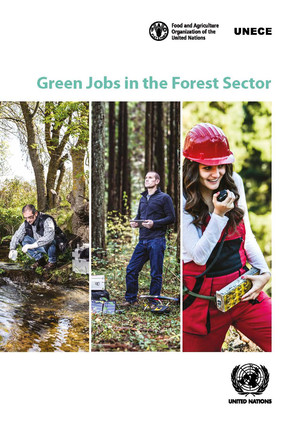
ECE/TIM/DP/71, the study Green Jobs in the Forest Sector provides an overview of existing Green Forest Jobs and identifies possible areas for future activities and jobs in the forest sector, and may serve as starting point for further analysis and discussion on the future of Green Forest Jobs. It offers a framework for classifying Green Forest Jobs under seven thematic work areas, outlined in the seven main sections of the study, with a particular focus on major trends, needs and challenges as well as opportunities and prospects for the forest sector. The findings suggest that to promote Green Jobs in the forest sector it is key to: (i) look at forest ecosystem services management as the frame for Green Forest Jobs; (ii) recognize the progress made in the development of Green Forest Jobs and to identify avenues for the future; (iii) enhance the public perception of jobs in the forest sector; (iv) revise existing curricula and develop new ones for catering to the needs of the sector to close the skills gaps; and (v) to facilitate an inclusive transition to green economy through training and support.
Read more..
State of Forests of the Caucasus and Central Asia
The study on the state of forests in the Caucasus and Central Asia aims to present the forest resources and the forest sector of the region, including trends in, and pressures on the resource, to describe the policies and institutions for the forest sector in the region and to list the major challenges the sector faces, and the policy responses in place or planned. The study is a cooperative effort by the author, the UNECE/FAO secretariat and national experts, done with the use of the best available data. It attempts to cover all dimensions of sustainable forest management and includes national overviews of all countries of the region.
Guidelines for the Development of a Criteria and Indicator Set for Sustainable Forest Management
Criteria and indicators constitute an increasingly common policy tool to implement sustainable forest management (SFM) and to define clear priorities and targets. This should improve monitoring, reporting and assessment of key aspects of SFM performance.
These guidelines provide specific concepts, definitions, tools and reference materials to guide the development process of national criteria and indicator sets for SFM. These guidelines have been developed to support the project “Accountability Systems for Sustainable Forest Management in the Caucasus and Central Asia” which is implemented through the UNECE/FAO Forestry and Timber Section and funded through the UN Development Account. The guidelines and the methods described within are used and applied for the development of national criteria and indicator sets for sustainable forest management in Armenia,
Georgia, Kazakhstan, Kyrgyzstan and Uzbekistan. The guidelines might be also relevant for other countries.
Forest Landscape Restoration in the Caucasus and Central Asia

This study, focusing primarily on the period from the collapse of the Soviet Union until the present day, identifies the key drivers of forest degradation and the potential for forest landscape restoration in the Caucasus and Central Asia. The study was undertaken to support the preparation of restoration pledges in the eight countries of the Caucasus and Central Asia in the run up to the Ministerial Roundtable on Forest Landscape Restoration and the Bonn Challenge in the Caucasus and Central Asia that took place in June 2018 in Astana, Kazakhstan. At this Roundtable Armenia, Georgia, Kazakhstan, Kyrgyzstan, Tajikistan and Uzbekistan committed to restore over 2.5 million ha of forest landscapes by 2030.
New manual promotes use of bamboo for climate change
A new manual aims to help countries calculate the climate mitigation potential of their native bamboo stocks.
Fast growing, with a high rate of carbon storage and a spread of 30 million hectares across the tropics and subtropics, bamboo could be an important part of countries’ nature-based toolkit for climate change mitigation. However, while there are many international guidelines for forest carbon assessment, very little information exists on measuring the carbon sequestration potential of bamboo. This is a critical knowledge gap, and affects the development of bamboo forests as a carbon sink.
Released in May, the Manual for Bamboo Forest Biomass and Carbon Assessment was developed by the International Bamboo and Rattan Organisation (INBAR) to provide clear instructions for technical staff who conduct bamboo forest inventories and bamboo carbon assessments. The manual provides an overview of bamboo stock and carbon estimation methodology, introduces various methods for data collection, and uses these tools as a basis to calculate bamboo stock, biomass and carbon sequestration in bamboo forest pools. INBAR will use the manual to train people across its 45 Member States to assess the carbon storage potential of their native bamboo species.
At a global level, the new manual should make an important contribution to understanding how bamboo forests can contribute to climate change mitigation. This is particularly relevant in the context of the Food and Agriculture Organization’s upcoming 2020 Forest Resource Assessment, which will include information on bamboo’s spread and carbon stock, using data collected from national agencies around the world.
The Manual for Bamboo Forest Biomass and Carbon Assessment can be downloaded here.
Measuring the Value of Forests in a Green Economy
This paper presents green economy related definitions and concepts, and internationally developed assessment methods, notably natural capital accounting approaches, and in this way explore aligning forest sector approaches to those being used in wider contexts. It also proposes preliminary suggestions on how the forest sector’s contribution to a green economy could be measured. Read more...
Events
Nature-based solutions at the 2019 International Horticultural Exhibition, Beijing, China

A bamboo pavilion promotes the use of nature-based solutions for sustainable lifestyles
Running from April to October, the International Horticultural Exhibition (Expo 2019) in Beijing, China, is set to be the largest of its kind: it covers 500 hectares of land and will be visited by an estimated 16 million guests. The theme of the Expo is ‘Live Green, Live Better’, and its many Pavilions showcase ways in which to live more sustainably.
Bamboo and rattan are multi-purpose solutions to a number of environmental and development challenges. With over 30 million hectares of bamboo and 400 species of rattan spread across the tropics and subtropics, these plants can help substitute timber products, prevent deforestation, protect biodiversity, restore degraded land, reduce rural poverty and combat climate change.
The International Bamboo and Rattan Organisation (INBAR) has been invited to host a large Garden at the Expo 2019, to promote the use of these plants in ‘green living’. The Garden includes:
- A ‘Bamboo Eye’ Pavilion covering 1600 metres squared and made entirely from round-pole bamboo - the largest structure of its kind ever built in the north of China, and one which shows the usefulness of bamboo as a replacement for steel, PVC and timber;
- Exhibitions and events showcasing bamboo and rattan’s role in poverty alleviation, land restoration, climate change mitigation and disaster-resilient construction;
- A Garden of over 2000 metres squared, containing winning designs from the International Bamboo Construction Competition 2019.
INBAR welcomes any visitors to Beijing to visit the Bamboo Eye Pavilion over the next six months. For more information, click here.
Expert Workshop and the Meeting of the Team of Specialists on Green Jobs in the Forest Sector

25 - 27 June 2019, Madrid, Spain
The Expert Workshop on "Green Forest Jobs: Facing challenges, exploring opportunities and increasing the capacity of UNECE member States" will take place in Madrid, Spain on 25-26 June 2019.
It will be followed by the third meeting of the UNECE/FAO Team of Specialists on Green Jobs in the Forest Sector (Joint ILO/UNECE/FAO Expert Network) on 27 June 2019.
The programme of the workshop can be found here. Practical information for participants can be found here. To register for the workshop please follow this link. To register for the ToS meeting please follow this link.
Latest in forest science to be showcased in Brazil
From September 29-October 5, Curitiba, Brazil, will be the site of the 25th IUFRO World Congress. These congresses of the International Union of Forest Research Organizations have been held at approximately five-year intervals for the past 127 years.
“A World Congress aims to maximize interdisciplinary interaction and to create opportunities for scientists to interact with others with similar interests beyond their usual network,” said Dr. Jerry Vanclay of Southern Cross University (SCU), Australia, and Chair of the IUFRO 2019 World Congress Scientific Committee (COC).
“At the Congress we expect to see a comprehensive overview of the state of our science in all aspects of forestry. In addition to updates from researchers, we’ll have a series of plenary sessions that will take the form of a dialogue between global science and policy leaders,” he said.
“That’s the whole point of the Congress; to help us all get updated with the latest developments and insights in all aspects of forestry in all the themes and disciplinary divisions,” he explained.
The five Congress themes – Forests for People; Forests and Climate Change; Forests and Forest Products for a Greener Future; Biodiversity, Ecosystem Services and Biological Invasions; and Forests, Soil and Water Interactions – are IUFRO’s key research themes.
Read this and other Congress Spotlight articles: https://www.iufro.org/media/iufro-spotlights/
Come and join us in Curitiba! Find out about the Congress: http://iufro2019. com/
2019 WFI International Fellowship Program – Forestry Lightning Talks

Meet eight International Fellows from around the world who came to Oregon to see how we meet global forestry challenges. They hope to take what they’ve learned here to improve their communities back home. Fellows will be sharing their project findings and how they are planning to implement their new knowledge back home. What we do in Oregon is inspiring people to impact their own corner of the planet.
Join us for the International Fellows‘ final presentations!
When: Thursday, September 12
Where: World Forestry Center / Cheatham Hall
Time: 5:30 to 7:30 pm
FREE EVENT, Doors open 5:30 pm, Talks begin 6:00 pm
Event link: https://www.worldforestry.org/event/2019-wfi-international-fellowship-program-forestry-lightning-talks/
Plantation forests to native forests: delivering multiple ecosystem benefits in a changing climate
EFI 2019 Scientific Seminar - 19 September in Aberdeen, UK
Mark your calendar! Come to discuss planted forest evolution in the UK and more globally. It will be a great opportunity to understand how planted forests can contribute to answer to the increasing wood demand induced by bioeconomy emergence, the challenge they face and their capacity to deliver multiple ecosystem services with native or non-natives species.
Registration will open in May. Further info: https://www.efi.int/membership/ac/2019
Save the date: Koli Forum 2019 - Wealth, Health and Wellbeing from Nordic Forests

Time: 9 – 10 October 2019, Venue: Koli National Park, Break Sokos Hotel Koli, Finland
The theme of the Koli Forum 2019 is Wealth, Health and Wellbeing from Nordic Forests reflecting the many versatile dimensions embedded in forestry. The goal of this 10th anniversary Koli Forum event is to view forestry and forest-based bioeconomy from a wider perspective where economic, social, environmental and cultural aspects are considered in a holistic way.
During the past 10 years Koli Forum has established itself as the high level discussion platform for global leaders on sustainable use of natural resources bringing together business leaders, policy makers, academia and civil society. The participants in this event will create a common understanding of the steps needed for the forest-based sector to become a true forerunner in sustainability.
Special focus in this year’s event will be placed on opportunities available through more intense Nordic cooperation, learning about the best practices in handling trade-offs and building new business eco-systems. Other topical issues on the agenda are the EU proposals related to sustainable finance, the latest understanding of the health benefits offered by forests as well as solutions to find a balance between tourism vs. climate and biodiversity impacts.
Koli Forum is known to be an excellent place for networking where the participants and speakers will have ample opportunities to discuss and establish important contacts. The speakers represent a wide range of organisations including e.g. the Nordic ministers of agriculture and forestry as well as the environment, forest industry executives, financial sector executives, university professors and international research organisations. https://koliforum.fi/save-the-date-koli-forum-2019-wealth-health-and-wellbeing-from-nordic-forests/
62nd SWST - Society of Wood Science & Technology - International Convention
The 62nd SWST International Convention will be held October 20-25, 2019, at Tenaya Lodge, just outside the gate of Yosemite National Park, California, USA. The overall theme is “Renewable Materials and the Wood-based BioEconomy “. Sessions include: Wood Physics and Mechanics; Wood Chemistry; Biodegradation and Preservation; Timber Engineering and Mass Timber; Composites and Adhesives; Business, Marketing and Regulations; International Innovation, Trends and Education in Wood Science; Forest Disturbances, Carbon and the Environment; Early Stage Researcher and a Poster Session. Registration: Early Bird – January 29, 2019 until July 15, 2019 – Student $400, Regular $550; July 16-September 15, 2019 – Student $425, Regular $575; Onsite (or after September 15, 2019) – Student $450, Regular $600. Regular and Student registrations include the Welcome Reception, Banquet, and 1 year membership in SWST. You can add any accompanying person(s) and their tickets to your registration. Register at https://swst2019convention.exordo.com/ Full convention information available at https://www.swst.org/wp/meeting/2019-international-convention-yosemite-national-park/
Conference WOOD-SCIENCE-ECONOMY 2019
Conference “Wood – Science – Economy”, 21-22 October 2019, Poznan, Poland, is the third international scientific conference organized by the Wood Technology Institute in cooperation with the State Forests National Forest Holding.
Both in Poland and abroad scientific conferences have so far been organized separately by the scientists in the field of forestry and those in the field of wood industry. However, the issues regarding forestry and wood management are so complex that they require multidisciplinary approach and new, innovative technological and organizational solutions. In the modern world fast exchange of the latest knowledge from the perspective of the entire wood chain is necessary.
The conference goal is to present the latest research findings in wood science, forestry and in the related fields, with particular emphasis placed on research with great implementation potential. The exchange of knowledge and experience in the contemporary challenges of wood-based industries among international specialists is the key to indicate research direction with the greatest potential for implementation and will contribute to increasing the competitiveness of the forest-based sector in the international area.
The conference is addressed to the representatives of science and economic practice in the field of forestry, wood industry, and neighbouring fields. More information: https://www.wood-science-economy.pl/
Forêt2019 - joint Session of the ECE Committee on Forests and the Forest Industry and the FAO European Forestry Commission

Forêt2019 - the joint 77th session of the ECE Committee on Forests and the Forest Industry (COFFI) and the 40th session of the FAO European Forestry Commission (EFC) will be held from 4 to 7 November 2019 in Geneva, Switzerland. In conjunction with Forêt2019, the 5th European Forest Week will be celebrated throughout Europe under the theme "Forests and the Circular Economy".
How to contribute? Deadline to provide contributions to the next issue is 15 September 2019. Please note that the content of the billboard does not necessarily reflect the views of the United Nations. Contributions are published as received and editing is the responsibility of the contributor. More information and the previous issues are available here.
We work in Collaboration with the Global Forest Information Service.













